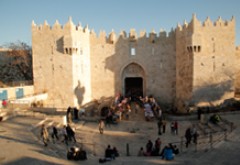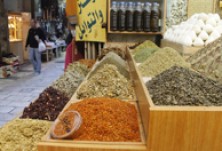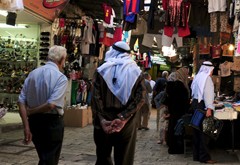Al-Jami’ al-Aqsa refers to the rectangular building with a ceiling and seven porticoes, located nearly in the middle of the southern wall of the Al-Aqsa Mosque. The current plan shows the latest development of al-Jami’ alAqsa , the result of architectural accumulations and changes stemming from different construction stages, whose numbers and dates historians and researchers have failed to agree on. This is due to several factors, including the fact that al-Jami’ al-Aqsa was not built on natural bed rock but rather on a structural base of columns and pillars, due to the area’s slope towards the south which required making up for the height difference. This is in addition to the many destructive earthquakes that hit the area, resulting in changes in the elements and area of al-Jami’ alAqsa .
Efforts of Caliph Umar ibn Al-Khattab
The first stage of building al-Jami’ al-Aqsa is attributed to Caliph Umar ibn al-Khattab, who is referenced by Mujir al-Din as building a mihrab and simple mosque, and adding that Caliph Umar, after clearing the area of al-Aqsa Mosque of debris and dirt and uncovering the holy Rock, consulted with his companions on the issue of the mihrab. He was told that he should place the mihrab in front of the Rock, but Umar refused and said that ‘We shall make the Qibla on the front, as the Prophet of Allah (God) made the Qibla in the front of our mosques.’ Traveler Arculf in 670 AD (49 - 50 H) provided a description for a simple mosque located in the southern arena of al-Aqsa Mosque, founded on great ‘wooden’ beams made from reused materials that were available in the area. He indicated that the mosque fits 3,000 worshippers. Nothing tangible of this al-Umari mosque, the first al-Jami’ al-Aqsa, remains now.
Founder
Old and contemporary historians have disagreed on dating the second stage or the second al-Jami’ al-Aqsa. The majority attributed it to ‘Abed al-Malik ibn Marwan (705 - 785 AD / 65 - 86 H), while others attributed it to al-Walid (705 - 715 AD / 86 - 96 H) on the basis of papyrus documents sent to the Umayyad governor of Egypt Qurra ibn Shurrik (709 - 714 AD / 90 - 96 H) in the era of al-Walid asking him to send materials and workers to Al-Aqsa. Others adopted a reconciliatory approach, saying that ‘Abed al-Malik started the project and al-Walid finished it.
Development of al-Aqsa Mosque
Regardless of who established the second al-Jami’ al-Aqsa, nothing remains of this Umayyad mosque except the southern wall, due to more than one earthquake that affected the area in the years 747 AD (130 H), 774 AD (158 H), and 1033 AD (425 H)), destroying major parts of the mosque and requiring reconstruction. Hamilton’s excavations in the area showed the presence of remains from the Umayyad, Abbasid and Fatimid eras, congruent with the constructions and renovations that were done on this mosque after the earthquakes.
Sponsorship of Al-Aqsa
As with the Dome of the Rock, al-Jami’ al-Aqsa was sponsored throughout its long history by caliphs, princes and kings. After a series of earthquakes, al-Jami’ al-Aqsa was maintained and renovated several times during the Abbasid era. The first time was in the era of Caliph Abu Ja’far al-Mansour, who rebuilt it after the mosque’s eastern and western parts fell. Moreover, Mujir al-Din had said: ‘Then there was the second tremor and the building of Abu Ja’far al-Mansour fell. Al-Mahdi came after, and al-Jami’ al-Aqsa was devastation. This was conveyed to him and he ordered its construction, saying: ‘This mosque is too high and too narrow and is void of men. Shorten its height and increase its width.’ The construction was done under his caliphate.’ In the era of Caliph al-Ma’moun (813- 833 AD / 198 - 218 H), the central middle portico was renovated, and under the rule of ‘Abed Allah ibn Tahir (820 - 822 AD / 205 - 207 H), renovations were made to the marble columns.
Efforts of the Fatimids in the Construction of al-Jami’ al-Aqsa
It seems that the planning of the current al-Jami’ al-Aqsa , which is the third one, namely the seven porticoes, was the result of multiple architectural developments that were done over various historical periods, whose starting date researchers also disagreed on. Nevertheless, they date back to the Fatimid period, particularly after the renovations undertaken by al-Zahar (1036 - 1094 AD / 411 - 427 H), which included the renovation of the large arch at the end of the middle porticoe and before al-Aqsa’s dome, namely the northern arch that carries the dome, and the renovations done by al-Mustanser (1094 - 1101 AD / 427-487 H), who renovated the northern façade of the middle porch in 1065 AD (458 H). A description of al-Aqsa was given by al-Muqaddisi in his time in 985 AD (375 H), indicating that it was made up of 15 porticoes. Another description was provided by Nasir Khusra dating back to 1048 AD (440 H), in which he spoke of 15 porticoes, the middle being the most expansive and covered by a pediment roof and a great dome, and with the seven porticoes on each side being of less height than the middle one. Based on al-Muqaddisi’s description, Hamilton’s studies, the works of architect Kamal al-Din, and the efforts of Ahmad Fakhri, it is possible to produce more than one design for al-Jami’ al-Aqsa in the Umayyad and Abbasid eras.
Efforts of Salah al-Din (Saladin)
In the era of the Franks, several works were done to al-Jami’ al-Aqsa that changed its features, including the set of capitales and carved columns that could be attributed to them. Nevertheless, Salah al-Din restored the mosque to its original state, renovated its I and brought over the Nour al-Din Zinki pulpit. Construction,renovation and additions continued on al-Jami’ al-Aqsa throughut the Islamic ages until it reached its current design and shape.








